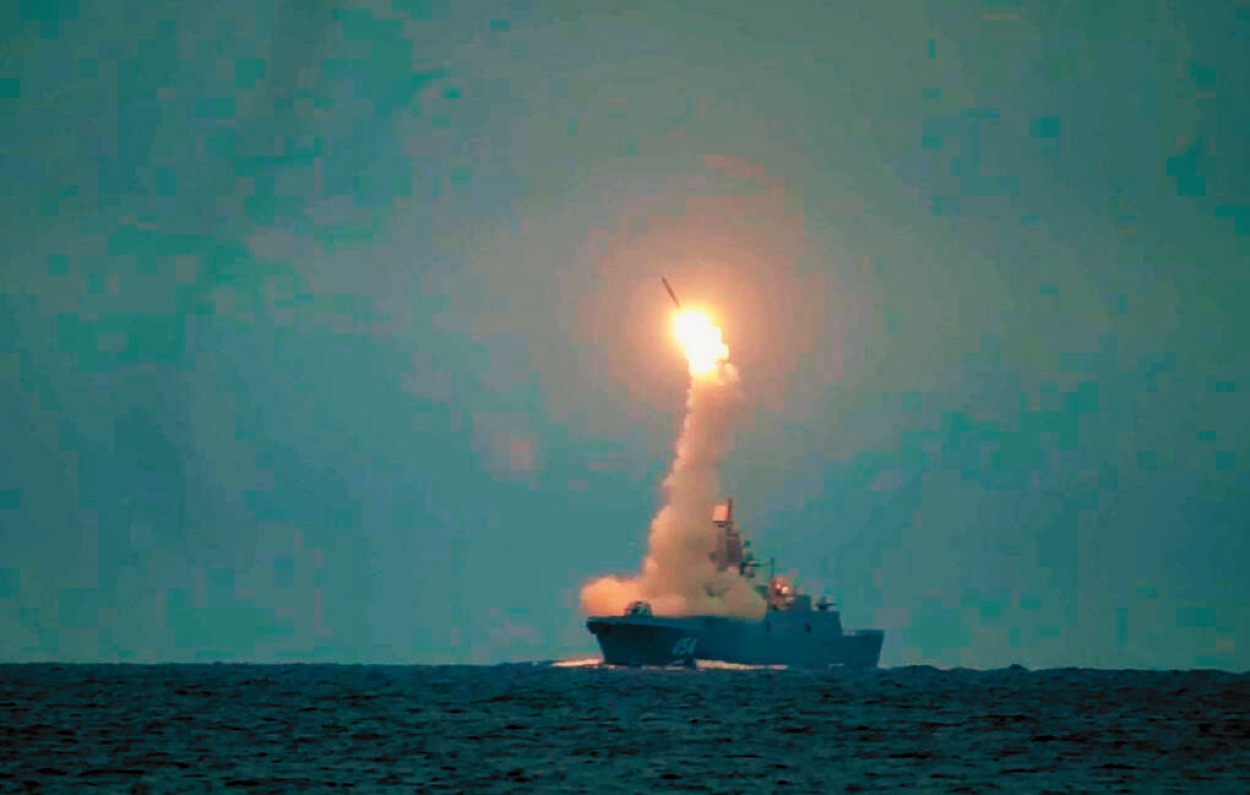The UK Defense Ministry has claimed that Russian forces likely utilized the land-based K-300 coastal defense system to deploy the Tsirkon hypersonic missile during the assault on Ukraine on February 7.
According to the ministry, this poses a substantial obstacle to Ukrainian air defense due to the missile’s remarkable speed and agility.
The Kyiv Scientific Research Institute of Forensic Expertise has recently confirmed Russia’s deployment of the 3M22 Zircon anti-ship missile during a large-scale missile strike on Ukrainian cities on February 7, resulting in casualties and injuries.
Director Oleksandr Ruvin said that specific components and markings characteristic of the Zircon missile were identified during the investigation, supporting the assertion of its involvement in the attack.
The Zircon missile, reputedly capable of traveling at speeds of up to Mach 9 and possessing an operational range of 1,000 km, was initially designed for deployment by the Russian Navy.
Latest Defence Intelligence update on the situation in Ukraine – 14 February 2024.
Find out more about Defence Intelligence's use of language: https://t.co/OvlDlvNrbQ #StandWithUkraine 🇺🇦 pic.twitter.com/lTY06hY59e
— Ministry of Defence 🇬🇧 (@DefenceHQ) February 14, 2024
However, the UK Ministry of Defense said that the absence of known vessels equipped to carry such missiles in the Black Sea has raised doubts about the launch method.
Due to constraints imposed by Turkey, neither of the naval vessels known to carry the missile have access to the Black Sea.
The UK intelligence suggests that the Russian K-300 coastal defense system may have been adapted.
“If its use is confirmed, this would present a significant challenge to Ukrainian air defense due to its speed and maneuverability,” the British Defense Ministry said.
The UK ministry further suggested that the Russians might use this conflict to test a newly operational weapon system in a combat scenario, aiming to reassure and demonstrate their capabilities.
Steve Brown, a former British Army Ammunition Specialist and Bomb Disposal Officer, pointed out that the heightened concern lies in the fact that, unlike the “early warning” generated by the take-off of MIG-31Ks carrying Kinzhals, a land-based system can be launched without any prior warning.
The K-300P Bastion-P (SSC-5 Stooge in NATO terminology) is a mobile coastal defense system that targets high-value naval vessels. Within Russian maritime strategy, it is considered the ultimate line of defense.
In addition to its primary anti-ship role, the Bastion-P system can launch land attack cruise missiles, as evidenced by its deployment in the Ukraine War.
However, due to its size and cost, it is deemed less optimal than the primary Russian cruise missile system, the Kalibr.
The Kalibr system is deployed aboard several warships of Russia’s Baltic Fleet, providing a more versatile and cost-effective option for land attack missions.
Tsirkon (Zircon) Hypersonic Missile
The Tsirkon hypersonic cruise missile has emerged as a formidable force in Russian naval warfare. With its cutting-edge scramjet propulsion and cooled supersonic combustion ramjet engines, the Tsirkon represents a new era of high-speed, precision weaponry.
The journey towards operational readiness began with the inaugural test launch aboard the first-in-class frigate, Admiral Gorshkov, in January 2020. Following this landmark event, rigorous live trials were conducted throughout 2020 and 2021, including a notable launch from the Yasen-class submarine K-560 Severodvinsk on October 4, 2021.
Russian President Vladimir Putin confirmed plans to equip Russian naval vessels with the Tsirkon missile system, including the newly commissioned Admiral Gorshkov frigate and the formidable Severodvinsk nuclear submarine.
The Tsirkon missile system is slated to replace the aging P-700 Granit and P-800 Oniks anti-ship missiles, offering unparalleled versatility and effectiveness on the battlefield. Utilizing the universal UKSK 3S14 missile launcher, the Tsirkon system promises to elevate Moscow’s naval defense capabilities.
Despite the limited information about the Tsirkon missile system, its designation as hypervelocity underscores its potential to outpace and outmaneuver existing missile defense systems.

In June 2022, Russia’s Ministry of Defense announced the official induction of the Tsirkon missile system into service, paving the way for mass production to commence immediately. Initial specifications included a 300-kilogram warhead, a range of 400 kilometers, and a flight speed of Mach 6.
However, Russia surprised observers with claims of extended range, stating a capability of 1,000 kilometers at a staggering speed of Mach 9 during an announcement.
As Russia continues to assert its position as a global military power, successfully deploying the Tsirkon hypersonic missile system represents a significant leap forward in its quest for military superiority and strategic dominance.
- Contact the author at ashishmichel(at)gmail.com
- Follow EurAsian Times on Google News




